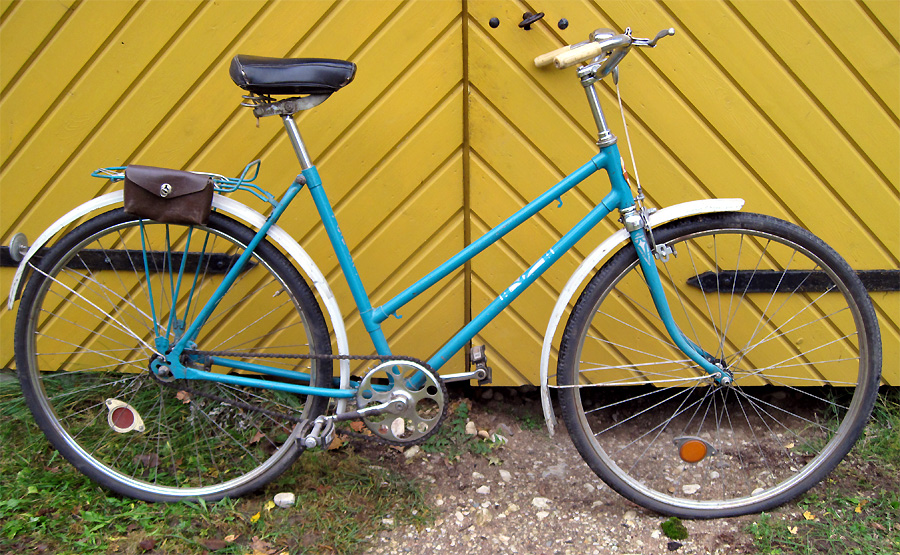Bicycle in the 1960s-80s
After Riga bicycle factory ended production of ordinary bicycles in 1961, the supply regions of Soviet Union bike factories were re-distributed according to governing planned economy. Thus Estonia was open to the production of other bicycle factories of the USSR, which, however, had low quality. The best produce at that time came from Kharkov Bicycle Factory (ХВЗ), the flagship of Soviet bike industry. We also received many bikes from Minsk Motorcycle and Bicycle Factory (ММВЗ) and Penza Bicycle Factory (ЗИФ, Завод имени Фрунзе in Russian). The quality of those bicycles was generally lower than Riga bikes, let alone that of pre-war bikes.
The 1960-80s did not bring anything new for ordinary bicycles in terms of technology either – instead of the standard model B-110 from the 1950s, its modifications B-111, B-112, etc. were introduced. These models had slightly updated appearance and details, and black colour replaced with other colours (since the second half of the 1960s), yet main assemblies of the bike were generally identical with German reparation bicycles of the 1940s (which reaches here up to early 1950s). Significant change in women’s bikes consisted in replacement of curved frame tubes with straight ones in the early 1960s. Ordinary Soviet bicycle had no gears until the end of Soviet era (late 1980s).
Main concern with these bikes was poor (or, to be more accurate, erratic) quality – it was impossible to know, which detail was going to break first or which component had poor assembly quality. Bikes had various problems – quickly broken axle, easily bent wheels, weak frame, broken freewheel, saddle springs, etc. While poor assembly could be improved by thorough inspection before use (many people did so), poor details could only be replaced, which was often problematic due to occasional lack of spare parts.
Meanwhile, a typical men’s or women’s bicycle without gears did not cost much in the 1960s-80s – on average one third to half average monthly wage, i.e. ca 60-90 roubles. Therefore, it was common to buy a new bike when the old one broke down. However, those who had time and desired to repair/build bikes often put the old bike aside for spare parts. Parts with higher quality were later on used to replace poor details of new bikes. Those who were ready to make an extra effort, could use reliable and more durable parts to assemble a bike that lasted longer than a new bike purchased from the store, and was more comfortable to ride.
Thus, in the 1960s-80s local roads were swarming with so-called “Soviet bicycles”, assembled piece by piece. Wherever possible, a “good old Estonian-age" (i.e. Estonian independence age or pre-WWII) frame was used, which was much more durable than Soviet ones. Many junctions of such bike were already (obviously due to natural wear and tear) replaced with new ones, and the only thing left from pre-war bike, was the frame, equipped usually with details from the 1950s-60s.
Therefore, the pre-war bicycle was rather common on the roads of Estonia until the end of Soviet era. However, they could not be used without rebuilding, because the pre-war standard tyres with beaded edges ended in mid-1950s (closed border, or “Iron Curtain“ prevented their import from Western world) and 28" tyre with wired edge could not be mounted on the wheel intended for beaded edge tyre due to different measurements. In such bikes, the wheels had to be replaced by new ones. Often such non-navigable bikes remained forgotten in the attic or shed, which is why so many pre-war bikes preserved up to present.
Unlike the 1950s-60s (and the 1920s-30s), local stores did not sell ready-to-go bicycles in the 1970s-80s. Chromed and painted parts usually had a coating of with conservation lubricant to prevent transportation damages; bell, reflectors and other small details were in separate package and not assembled, etc. Perhaps the manufacturers initially thought that the stores would prepare the bikes, but this did not happen – under the conditions of inherent goods deficit in the Soviet planned economy, it was easy to sell the bikes in that condition. As it was reasonable to perform full inspection of new bike anyway (check the lubricant in bearings, adjustment, tighten screws and bolts, tighten spokes, etc.), this assembly was usually not a problem for the purchaser.
The quality of bicycles (as well as other technical equipment) dropped drastically in the early 1980s, when Western countries imposed export embargo on the Soviet Union due to its invasion to Afghanistan, which affected availability of strategic materials and technologies. USSR was unable to replace all micro additives, specific workbenches, technology, etc. with own produce, resulting in major decline in quality in engineering industry for several years. Many bikes made in 1982-85 had bent frames after first ride; wheels were crooked, pedal shafts broke, bearing cones wore out, etc.

